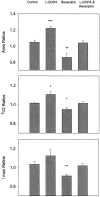VMAT-Mediated changes in quantal size and vesicular volume
- PMID: 10884311
- PMCID: PMC6772308
- DOI: 10.1523/JNEUROSCI.20-14-05276.2000
VMAT-Mediated changes in quantal size and vesicular volume
Abstract
It has been well established that the volume of secretory vesicles can be modulated. However, we present the first data demonstrating that the amount of transmitter in a vesicle can regulate its volume. Amperometry and transmission electron microscopy have been used to determine that l-3,4-dihydroxyphenylalanine and reserpine increase and decrease, respectively, the volume of single pheochromocytoma cell vesicles as well as their catecholamine content. Because changes in vesicular catecholamine content are tracked by changes in vesicle volume, our results indicate that when quantal size is altered via the vesicular monoamine transporter the concentration of catecholamines within the vesicles remains relatively constant. This previously unidentified cellular response provides new insight into how catecholamines can be packaged in and released from secretory vesicles.
Figures






References
-
- Albillos A, Dernick G, Horstmann H, Almers W, Alvarez de Toledo G, Lindau M. The exocytotic event in chromaffin cells revealed by patch amperometry. Nature. 1997;389:509–512. - PubMed
-
- Borges R, Travis ER, Hochstetler SE, Wightman RM. Effects of external osmotic pressure on vesicular secretion from bovine adrenal medullary cells. J Biol Chem. 1997;272:8325–8331. - PubMed
-
- Brodwick MS, Curran M, Edwards C. Effects of osmotic stress on mast cell vesicles of the beige mouse. J Membr Biol. 1992;126:159–169. - PubMed
-
- Chen TK, Luo G, Ewing AG. Amperometric monitoring of stimulated catecholamine release from rat pheochromocytoma (PC12) cells at the zeptomole level. Anal Chem. 1994;66:3031–3035. - PubMed
Publication types
MeSH terms
Substances
LinkOut - more resources
Full Text Sources
